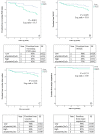Urinary Cystatin C Has Prognostic Value in Peripheral Artery Disease
- PMID: 35883416
- PMCID: PMC9313414
- DOI: 10.3390/biom12070860
Urinary Cystatin C Has Prognostic Value in Peripheral Artery Disease
Abstract
Despite its association with adverse outcomes, peripheral artery disease (PAD) remains undertreated. Cystatin C is elevated in patients with renal disease and may be a marker of cardiovascular disease. We examined the prognostic ability of urinary Cystatin C (uCystatinC) in predicting adverse PAD-related events. In this prospective case-control study, urine samples were collected from patients with PAD (n = 121) and without PAD (n = 77). The cohort was followed for 2 years. uCystatinC was normalized to urinary creatinine (uCr) (uCystatinC/uCr; μg/g). The primary outcome was major adverse limb event (MALE; composite of vascular intervention (open or endovascular) or major limb amputation). The secondary outcome was worsening PAD status (drop in ABI ≥ 0.15). Multivariable Cox regression and Kaplan-Meier analyses were performed to assess the prognostic value of uCystatinC/uCr with regards to predicting MALE and worsening PAD status. Our analysis demonstrated that patients with PAD had significantly higher median [IQR] uCystatinC/uCr levels (24.9 μg/g [14.2-32.9] vs. 20.9 μg/g [11.1-27.8], p = 0.018). Worsening PAD status and MALE were observed in 39 (20%) and 34 (17%) patients, respectively. uCystatinC/uCr predicted worsening PAD status with a hazard ratio (HR) of 1.78 (95% CI 1.12-2.83, p = 0.015), which persisted after controlling for baseline demographic and clinical characteristics (adjusted HR 1.79 [95% CI 1.11-2.87], p = 0.017). Patients with high uCystatinC/uCr had a lower 2-year freedom from MALE (77% vs. 89%, p = 0.025) and worsening PAD status (63% vs. 87%, p = 0.001). Based on these data, higher uCystatinC/uCr levels are associated with adverse PAD-related events and have prognostic value in risk-stratifying individuals for further diagnostic vascular evaluation or aggressive medical management.
Keywords: Cystatin C; major adverse limb events; peripheral arterial disease.
Conflict of interest statement
The authors declare no conflict of interest.
Figures

References
-
- Zemaitis M.R., Boll J.M., Dreyer M.A. StatPearls. StatPearls Publishing; Treasure Island, FL, USA: 2021. [(accessed on 14 June 2021)]. Peripheral Arterial Disease. Available online: http://www.ncbi.nlm.nih.gov/books/NBK430745/ - PubMed
-
- Welten G.M.J.M., Schouten O., Hoeks S.E., Chonchol M., Vidakovic R., van Domburg R.T., Bax J.J., van Sambeek M.R.H.M., Poldermans D. Long-term prognosis of patients with peripheral arterial disease: A comparison in patients with coronary artery disease. J. Am. Coll Cardiol. 2008;51:1588–1596. doi: 10.1016/j.jacc.2007.11.077. - DOI - PubMed
-
- AbuRahma A.F., Adams E., AbuRahma J., Mata L.A., Dean L.S., Caron C., Sloan J. Critical analysis and limitations of resting ankle-brachial index in the diagnosis of symptomatic peripheral arterial disease patients and the role of diabetes mellitus and chronic kidney disease. J. Vasc. Surg. 2020;71:937–945. doi: 10.1016/j.jvs.2019.05.050. - DOI - PMC - PubMed
MeSH terms
Substances
LinkOut - more resources
Full Text Sources
Medical
Miscellaneous

